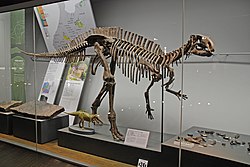| Fukuisaurus Temporal range: Early Cretaceous, | |
|---|---|
 | |
| Reconstructed skeleton | |
| Scientific classification | |
| Kingdom: | Animalia |
| Phylum: | Chordata |
| Class: | Reptilia |
| Clade: | Dinosauria |
| Clade: | † Ornithischia |
| Clade: | † Ornithopoda |
| Clade: | † Ankylopollexia |
| Clade: | † Styracosterna |
| Genus: | † Fukuisaurus Kobayashi & Azuma, 2003 |
| Species: | †F. tetoriensis |
| Binomial name | |
| †Fukuisaurus tetoriensis Kobayashi & Azuma, 2003 | |
Fukuisaurus (meaning "Fukui (Fortunate) lizard") is a genus of herbivorous ornithopod dinosaur that lived during the Early Cretaceous in what is now Japan. The type species is F. tetoriensis, which was named and described in 2003. [1]

